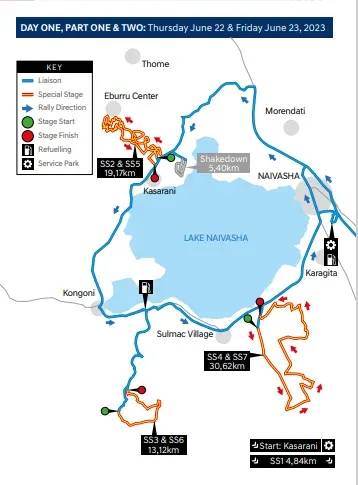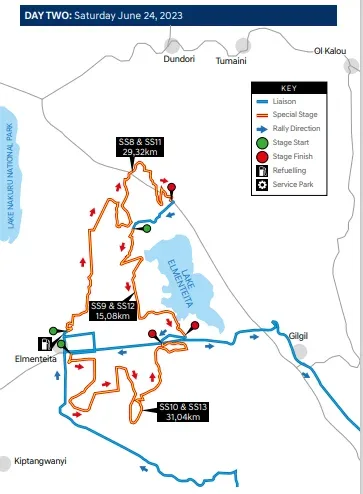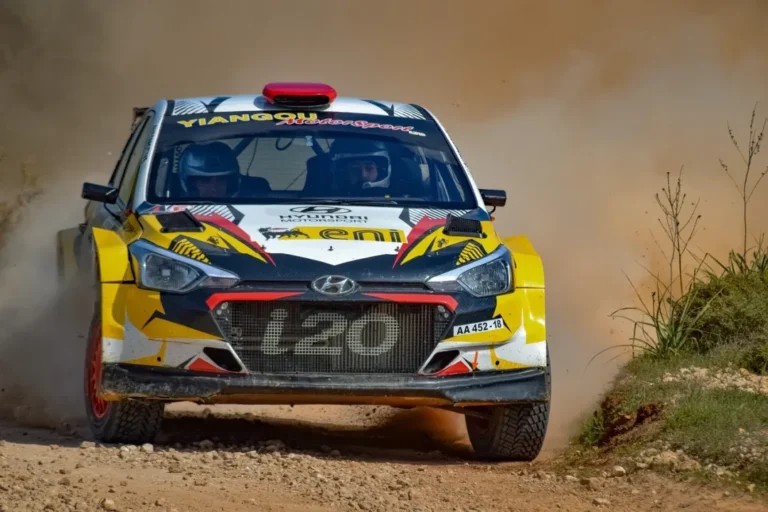As rally fans gear up for the 2023 WRC Safari Rally that will take place this weekend in Naivasha, there’s still a lot of mystery surrounding the sport that Kenya has hosted for decades. It always seems like the rally drivers show up from nowhere with their powerful machines, blow dust on thousands of cheering fans then leave until the next race. However, it’s more complicated than that. Like any other sport, there are rules, requirements and governing bodies that regulate the sport that many don’t realize. For instance, did you know that this thrilling sport was introduced in Kenya in honour of Queen Elizabeth II?
Here are things you need to know about the WRC Safari Rally.
History
Kenya is no stranger to hosting the WRC and is one of the 18 stages that make up the iconic Safari Rally. The epic marathon is nearly 2,000 kilometres (1,240 miles) on often unforgiving terrain which has proved to be a challenge for some drivers and a favourite for others. Some drivers have gone as far as to say that this is their favourite terrain.
What’s not to love about the Safari Rally? It’s hosted in some of the most beautiful places in the world that truly test the competitor’s driving skills and their machine’s capabilities. This was the inspiration behind the founder’s need for a driving competition. The founder of the Safari Rally Eric Cecil, his cousin Neil Vincent and a friend Eric Tromp were sharing a drink in a bar at Limuru when the motorsport enthusiasts started talking about their favourite sport. At that time, there were several circuits in the country but one of the men wanted a more challenging event.
“I can’t be bothered running around in circles. But if you could organize an event where we get into our cars, slam the doors and go halfway across Africa and back and the first car was the winner, then I will enter,” said Vincent.
As an adventurer, Cecil took up the challenge and came up with several routes including a trip around the 68,000km Lake Victoria. He eventually settled on an ideal course and approached the EAAA who quickly rejected his proposal. He approached them again, days after Queen Elizabeth received news of her father’s death while in the country. He thought it was a good idea to host an event to commemorate this historic moment that happened in Kenya which they accepted. He got two sponsors, the East African Standard newspaper and Shell Oil, who gave 500 pounds each and the Safari Rally came to life.
It was born as the East African Coronation Rally in 1953 but later changed its name to Kenya Safari Rally in 1974 after Tanzania whose political relationship with Kenya was beginning to wane opted out. The sport continued flourishing and attracted petrol heads of all ages from around the world as participants and spectators. It also became one of the most talked about events in the country. Some Kenyan drivers like Joginder Singh and Ian Duncan still hold their status as national heroes to this day.
The Safari Rally has had some growing pains but one of the most significant blows it suffered was when Kenya lost its hosting rights for 19 years. The birthplace of the Safari Rally could no longer be a host due to international standards that the event failed to meet. Kenya hosted its first WRC in 2021 after nearly 2 decades’ absence after former President Uhuru Kenyatta promised to bring it back.
Rules & Requirements
Some former Safari Rally drivers recall how they never had to wear any protective clothing. They would simply show up in a t-shirt and drive their cars. Gloves were also optional. However, as the sport grew in popularity, the International Automobile Federation (FIA), had to step in to ensure the event was up to standard. FIA is a governing body for several auto-racing events including the WRC which ratifies certain rules and regulations based on expert recommendations. For instance, FIA World Motor Sport Council gave the green light to technical rules for the WRC’s exciting new environmentally-friendly rally cars in 2022.
Some of the rules of the World Rally Championship are as follows:
For the car
- Formerly known as World Rally cars, Rally1 cars must have a steel monocoque chassis with additional safety features like roll cages and impact protection systems.
- The cars are equipped with turbocharged four-cylinder engines with a displacement of 1.6 litres mounted in a traverse position. Teams are permitted six engines each season – two per car for a three-car team.
- Hybrid technology was introduced to the list of regulations. The cars will have a combination of an internal combustion engine (ICE) and an electric motor. They will still resemble the aggressive aesthetic of traditional rally cars.
- Rally1 cars also feature advanced electronic systems to monitor and control various aspects of the car’s performance, including traction control, anti-lock braking systems (ABS), and engine mapping.
- Rally1 cars must have aerodynamically optimized bodywork to generate downforce, improve stability, and enhance handling at high speeds. This includes front and rear spoilers, side skirts, and diffusers.
- They must comply with strict safety standards set by the FIA such as incorporating various safety features like roll cages, harnesses and fire extinguishers.
- The minimum weight of a Rally1 car is typically around 1,230 kilograms (2,711 pounds) including the driver and co-driver.
- The suspension system is specially designed to handle rough terrains encountered in rallying. It includes adjustable dampers, springs, and anti-roll bars to provide optimal control and traction.
- The cars have all-wheel drive (AWD) systems for maximum traction on various surfaces and can use sequential gearboxes, usually with six or seven forward gears and one reverse gear.
For the driver
- Drivers who want to participate in the WRC should be of good health, physical fitness and demonstrate high levels of strength, endurance and agility. The medical examinations assess various aspects of health, including cardiovascular fitness, vision, and overall physical well-being.
- They must also comply with FIA’s safety regulations which include wearing a fireproof racing suit, gloves, racing boots, and a helmet.
- Drivers must be at least 18 years old to compete.
- Drivers must have appropriate insurance coverage, including personal accident insurance, liability insurance, and vehicle insurance.
- They must hold a valid competition license issued by the national motorsport governing body in their respective countries.
- They must secure sponsorship or have contracts with teams or manufacturers to fund their participation in the championship.
- Drivers must adhere to the general code of conduct established by the organizing bodies and the championship such as respecting fellow drivers.
For the race
- Competitors drive to and from each stage on public roads, observing normal traffic regulations.
- Penalties are incurred by competitors who arrive late at control points such as entrance and service parks. Time penalties are also applied if a competitor exceeds the allotted time in service.
- There are three service sessions in a day – a 15-minute session before the opening stage, a 40-minute session midway through the day’s race, 45-minute session at the end of the day’s race.
- Outside the service park, only a driver and co-driver can work on their car, using only tools and spare parts carried onboard.
- After each day’s competition, the cars are kept in a secure location with no access to participants of the rally.
- Drivers can still participate in a race despite getting mechanical issues or an accident. However, for every special stage missed, a competitor incurs a 10-minute penalty.
- Each rally features a number (typically between 15 and 25) of timed sections – known as special stages – on closed roads. Drivers battle one at a time to complete these stages as quickly as possible, with timing taken to 1/10th second.
- They start with two days of reconnaissance in which drivers and co-drivers practice the route at limited speed to make pace notes. During the race, the co-driver uses these notes to guide the driver and explain the hazards ahead.
- The event technically starts on Thursday night with a short fan-favourite stage in a stadium or through the streets of the host town. After that, the competition continues for the next three days, before ending on Sunday with the rally-closing Power Stage. This offers bonus points for the fastest five drivers.
- The crew which completes all the stages in the shortest cumulative time is the rally winner. WRC points are allocated to the top 10 finishers on a 25-18-15-12-10-8-6-4-2-1 basis in both the drivers’ and manufacturers’ championships i.e. 1st place gets 25 points.
The 2023 WRC Safari Rally will take place as from Thursday, 22nd June to Sunday to 25th June 2023. The Rally will kick off with flag-off at Nairobi’s Uhuru Park on Thursday, 22 June 2023 and thereafter crews will head to the Kasarani Grounds for the Super Special Stage after which they will head to Naivasha for the main event.
In the WRC1 category, we have the points leader and defending Safari Rally champion Kalle Rovanpera. Other notable international drivers who have confirmed their participation are Sébastien Ogier, the 2021 WRC Safari Rally Champion, Ott Tänak, Evans Elfyn, Thierry Neuville, Esapekka Lappi, Dani Sordo, Katsuta Takamoto, and Solberg Oliver.
In the WRC2 category, we have Kenya’s Karan Patel who will be up against last year’s class winners Kajetan Kajetanowicz from Poland, Oliver Solberg, and Grégoire Munster, among others. With only one foreign crew in the WRC3 category, Diego Dominguez of Paraguay, Kenya’s Hamza Anwar, Jeremiah Wahome, and McRae Kimathi will be representing us. The rest of the Kenyan team comprises of Tundo Carl, Virani Aakif, Canobbio Piero, Singh Vohra Samman, Kavisi Evans, Rathod Minesh, and Kariuki Josiah.
Safari Rally Stages
The Safari Rally will have a total of 19 special stages (SS1 to SS19) with one unique additional route – (Malewa) to complete a total competitive distance of 356.98 kilometres. The Safari Rally Route 2023 is virtually identical to the 2022 rally, apart from a few fairly minor adjustments to some stages the only real difference is the replacement of the Narasha stage with the Malewa stage.
Day One
Super Special Kasarani will be 4.84 km and will run twice (2 times).
Day Two
Loldia will be 19.17km and will run twice. One of the fastest stages is Geothermal which is 13.12 km and will also be run twice. (a stage first introduced in 2022 which climbs over craggy rock-lined hills). Kedong better known for its Fesh Fesh is 30.62 km and will run twice.

Day Three
Soysambu is 29.32 km and will run twice, Elementaita is 15.08 km and will also run twice. Sleeping Warrior, the longest and probably the most exciting stage especially in the wet (If it rains) is 31.04km. This is the longest stage of the 2023 WRC Safari Rally.

Day Four
Malewa 9.0km which is back after being replaced by Narasha last year is 8.33 km and will be run twice. Oserian will be 18.33 km and will run twice while Hells Gate is 10.53km. The second pass through Hell’s Gate, which finishes amid stunning scenery at Fischer’s Tower, forms the Wolf Power Stage with bonus points on offer for drivers and manufacturers.


